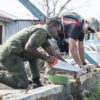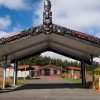By Ms. S.J. Patterson
Dear Editor,
Get rid of the Light Gun? Them’s Fightin’ words!
I would like to respond to your recent article “An alternative to light guns: a debate worth having.” Please note that I do not express the views of the Royal New Zealand Artillery (RNZA) as a whole, but my professional opinion as an RNZA officer.
I wholeheartedly agree with the author that we should be challenging the status quo, including our outputs, concepts, structures and traditional norms. The current fires capability is but one of the warfighting functions that should be critically reviewed to ensure that the NZ Army remains relevant and aligned with CA’s strategy and intent. Perhaps though we should start with reviewing our manoeuvre concept and capabilities and then design our fires capability to support that. As a gunner advising my Manoeuvre Commander (MAC) who was about to attack an enemy position I would say “I can’t develop a fire plan until you have a manoeuvre plan Sir”.
Manoeuvre concept aside, there is one thing that is clear in Army 2025 and the Multi-role Battalion Group framework for the future of our fires; that we need capabilities that are also multi-role and that can support manoeuvre across the spectrum of operations. Unlike larger armies, we do not have the flexibility of having a ‘toolbox’ of systems to task-organise according to the situation, so we have to be smart in the capabilities we acquire and how we employ them. Kiwi gunners love their light guns, however as a corps we’re actually delivery system agnostic. One of the first things you learn as a gunner is that the weapon of the artillery is the projectile, not the gun (or delivery system). The true value the RNZA brings to the fight (beyond smashing a target with high explosive obviously) is the integration of effects (both kinetic and non- kinetic and/or lethal/non-lethal). The author misses this point entirely. A mortar Platoon, whilst an excellent capability for supporting light infantry does not bring a coordination function (the Joint Fires and Effects Coordination Centre (JFECC) and Joint Fires Teams) to coordinate all of these effects for the MAC. Even within the NZ construct these effects could be beyond just mortars and guns. They could also include coalition/NZ assets such as rotary or fixed wing aircraft, naval guns, Air Defence, Surveillance Target Acquisition systems, Information Operations and Electronic Warfare effects. The JFECC is the hub of coordination for a NZ Battle Group organisation.
Every fires system has inherent strengths and weaknesses including the 81mm mortar and the light gun. That is why fires professionals attempt to ‘layer’ fires to mitigate these vulnerabilities and leverage off strengths. Mortars and guns should generally not be an either/or conversation but task-organisation will always depend on the manoeuvre operation and task. Mortars have a high rate of fire, however guns are generally more consistent and accurate. They are complimentary. A fires professional from the RNZA would consider what is best suited to task-organise to support manoeuvre based off a range of factors. The author suggests that the light gun is no longer fit for purpose. Based on what evidence? To support what manoeuvre operations, missions and tasks? I also challenge that the light gun is not sustainable by combat service support. Based on what staff check or evidence? Our logistics planners would plan a CSST based on the requirement of the operation, including the provision of artillery or mortar ammunition (amongst other ammunition types utilised by our manoeuvre forces). The author also raises that having a Battalion organic artillery capability is not what our partners do. This is largely due to organisational scale and the fact that centralised fires are flexible enough to achieve centralised massed effects, whilst being able to quickly decentralise to support tactical units. A RNZA fire unit could be organic to a NZ Battle Group, or be part of coalition fires, or a combination of both (this is why fires have unique C2 relationships – to enable this). Light gun batteries are designed to support manoeuvre battalions to provide guaranteed, sustainable and dependable fire support. One of the key reasons why mortars and guns are such a dependable capability is that many aircraft based systems cannot operate in poor weather (including switchblade). Moreover, projectile systems that rely on GPS or other navigational aids can also be vulnerable to interference. Yes, we should be exploiting modern systems and technologies and increasing our precision and lethality. However, I suspect that there will always be a place for a good old high explosive projectile.
The 81mm mortar and the light gun remain dependable indirect fire systems across the spectrum of operations. I want to reassure our manoeuvre brothers and sisters that when you need fires, the RNZA can deliver a flexible and integrated capability regardless of weather, season, or terrain. If the author’s opinion is shared by other manoeuvre professionals then perhaps we have an impetus to review what combined arms training we are conducting. A Battle Handling Exercise will only ever have limited training objectives that won’t test all of the elements of combined arms mastery. It also demonstrates the importance of the exercises we do in Australia, where we are generally part of Brigade manoeuvre with integrated fires.
Finally, I would like to thank the author for his article. This is a debate worth having. All warfighting professionals should be constantly reviewing the relevance of their capability as the characteristics of war change. I look forward to the debate about the manoeuvre concept. If the author would like some gunner input then he knows where to find us.






